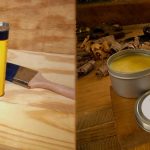How To Clean Polyurethane? (Expert’s Guide to Clean Polyurethane Surfaces)
Imagine you have applied a polyurethane finish on a surface and you did it completely wrong. So, you now have to clean the whole polyurethane surface and redo the finishing again.
In such a situation, how to clean the Polyurethane surface? Well, you can clean polyurethane simply using mild soap and water or specialized cleaners designed for use on polyurethane finishes. Basic cleaning can be performed with a soft sponge or microfiber cloth.
For tougher dirt or stains, you may need to use a plastic-bristle scrub brush and a solvent-based cleaner. Now, we know you need more than this to help you out. So, let’s dive into the step-by-step process for cleaning and caring for polyurethane finishes.
How To Clean Polyurethane Surfaces?
Polyurethane finish requires expert care during cleaning to preserve its luster and longevity. You’ll have to go through the below steps to properly clean your polyurethane surface.
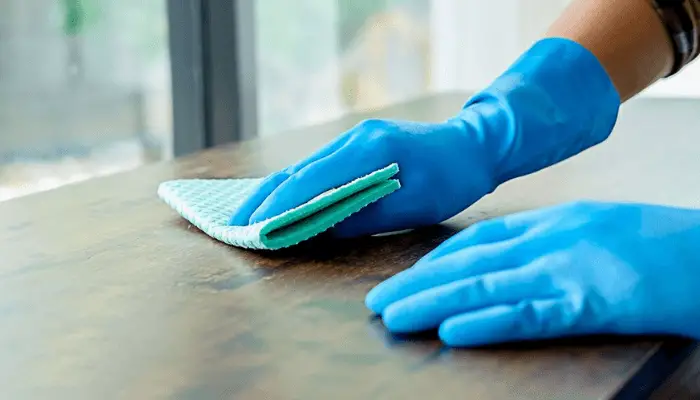
A. Choosing Your Cleaning Agents for Polyurethane Surfaces
- First, you have to choose non-abrasive cleaning agents with a neutral pH (not acidic nor caustic).
- A suitable cleaning agent is a mild dish soap diluted with water. This is gentle enough not to damage the polyurethane finish but effective in removing dirt and stains.
- If you need to tackle harder-to-remove stains or grime, consider using a commercially available and specially formulated polyurethane cleaner. They’re made to handle more stubborn cleaning tasks without harming the finish.
B. Basic Cleaning Processes
Here are the basic processes of cleaning polyurethane surfaces that you can try right at home.
Step 1. Dry Dusting
Start by dusting the surface with a soft, dry, non-abrasive cloth or microfiber duster to remove loose particles of dust and dirt. This dry dusting will prevent scratches from the coarse particles during the subsequent wet cleaning.
Step 2. Wet Cleaning
- Add some mild dish soap and hot water to a bucket. The ideal ratio is one teaspoon of dish soap to a quart of water.
- Soak a clean, gentle cloth in the soap water.
- Squeeze out the extra liquid and softly wipe down the surface.
Step 3. Stubborn Stains
- Use a little portion of polyurethane-safe cleaner for tougher stains directly onto the stain. Some of the best commercially available Polyurethane cleaners are Touch ‘n Seal Poly-Clean Polyurethane Rubber Foam Cleaner, Lundmark Poly-Clean, etc.
- Using a piece of soft fabric, gently rub the area until the stain lifts.
- Make sure you avoid using excessive force or a scrubbing motion that can damage the polyurethane layer.
Step 4. Polish (Optional)
If your polyurethane finish is a high gloss, you can finish the cleaning process with a light polish using a soft, dry cloth. This step will assist you in bringing back the shininess and remove any lingering streaks or smudges.
Advanced Cleaning Processes For Different Types Of Polyurethane Finish
The type of polyurethane you have to clean will determine the best products and tools to use for cleaning it.
So, let’s begin learning the types of polyurethane, such as water-based and oil-based polyurethane.
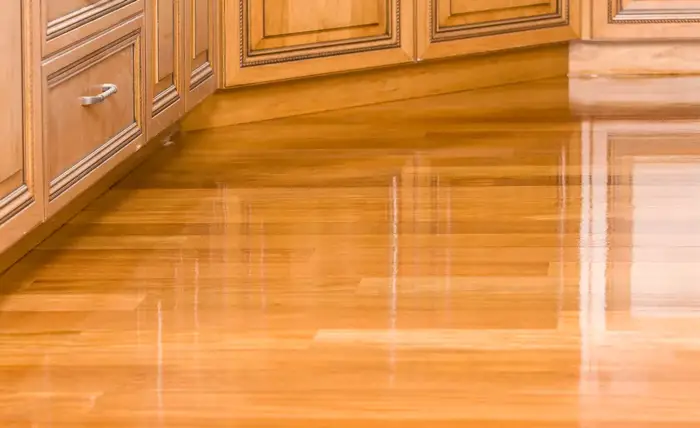
1. Water-based polyurethane
- This finish stands out as a crystal clear type of finish that does not add color to the surface and preserves its natural tone.
- Water-based polyurethane is easier to clean than oil-based polyurethane because it can be dissolved with water and mild detergent.
- However, water-based polyurethane is less durable and resistant to heat and chemicals than oil-based polyurethane.
2. Oil-based polyurethane
- This polyurethane is known for its rich amber hue and the way it brings out the wood’s original grain.
- Despite being a common option for flooring and furniture, it is more difficult to clean than polyurethane, which is based on water.
- Oil-based polyurethane cannot be dissolved in water and requires solvent-based products to remove it.
- It is more toxic and flammable than water-based polyurethane. And it requires proper ventilation and safety precautions when cleaning.
What you will need for the cleaning process
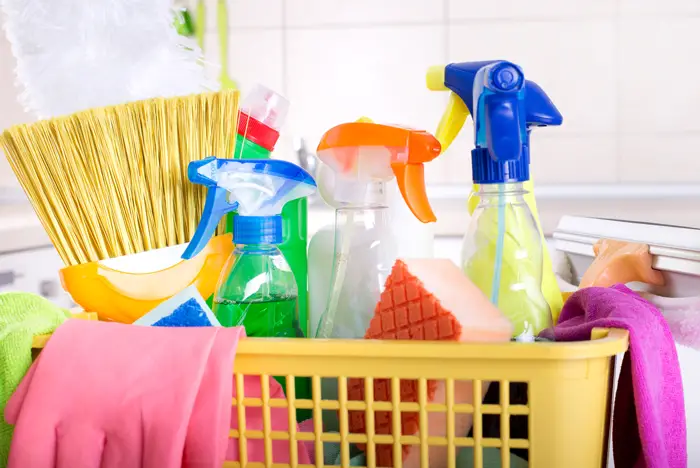
For water-based polyurethane, you will need the following items:
- A bucket of warm water
- Mild detergent or dish soap
- Soft cloth or sponge
- Dry cloth or towel
- A furniture polish (optional)
For oil-based polyurethane, you will need the following items:
- A large quantity of paint thinner or mineral spirits
- Metal container with a lid
- A paint brush comb or wire brush
- Pair of rubber gloves
- Pair of goggles
- Respirator mask
- Rag or paper towel
- A furniture polish (optional)
A. Cleaning polyurethane on wood and metal
Let’s start with wood and metal. They’re the most common surfaces that are coated with polyurethane.
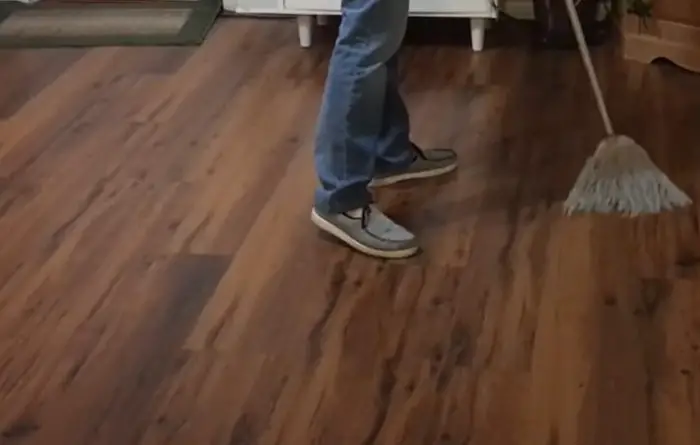
To clean polyurethane from wood and metal, follow these steps:
Step 1: Identify the type of polyurethane you have. If you are not sure, you can test a small area with water.
If the water beads up on the surface, it is oil-based. If the water soaks into the surface, it is water-based.
Step 2: Mix some mild detergent or dish soap in a heated water bucket if you have water-based polyurethane. Scrub the area carefully using a sponge or cloth dipped in the solution.
Step 3: If you use oil-based polyurethane, put some paint thinner or mineral spirits in a metal vessel with a lid.
Dip a paintbrush comb or wire brush into the solvent and scrape off the excess polyurethane from the surface.
Step 4: Dry the area using a clean towel or cloth.
Step 5: Apply a furniture polish if you want to restore the shine and protect the surface from dirt and grime.
B. Cleaning polyurethane on clothes
To clean polyurethane from clothing, follow these steps:
Step 1: Identify the type of polyurethane you have. If you are not sure, you can test a small area with water.
Step 2: Soak the clothing in warm water for 10 minutes if you have water-based polyurethane.
Then, simply wash it in cold water with detergent as you normally would.
Step 3: If you have oil-based polyurethane, scrape off as much of the polyurethane as possible with a knife or spoon.
Then, apply an enzyme-based cleaner (such as the Puracy Stain Remover or the Dirty Labs Bio-Enzyme) to the stain and let it sit for 15 minutes.
Wash it as usual with laundry detergent and cold water.
Step 4: Check if the stain is gone before drying the clothing.
Mistakes To Avoid When Cleaning Polyurethane
Cleaning a polyurethane surface is a complex task. So, it can lead to a major blunder if you don’t be cautious about the following:
- Always clean polyurethane as soon as possible after applying it. It prevents it from hardening and becoming more difficult to remove.
- Always wear protective gear when cleaning oil-based polyurethane, such as gloves, goggles, and respirator mask.
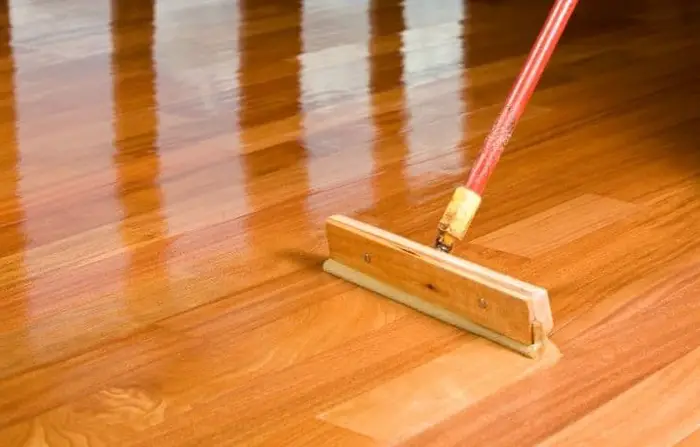
Oil-based polyurethane can irritate your skin, eyes, and lungs if exposed.
- Always work in a well-ventilated area when cleaning oil-based polyurethane, such as outdoors or in a garage with open windows and doors.
Oil-based polyurethane can emit harmful fumes that can cause headaches, nausea, and dizziness if inhaled.
- Do not pour the used solvent down the drain or into the trash. They can contaminate the water supply or cause fire hazards.
Instead, seal them in a metal container with a lid and take them to a hazardous waste facility.
- Always start cleaning by testing a small area before cleaning the full polyurethane surface.
It is to make sure the cleaning solvent does not damage or discolor the surface.
Advanced Techniques for Removing Scratches from Polyurethane Finishes
Here are the steps that you should follow to remove any existing scratches on your polyurethane surface:
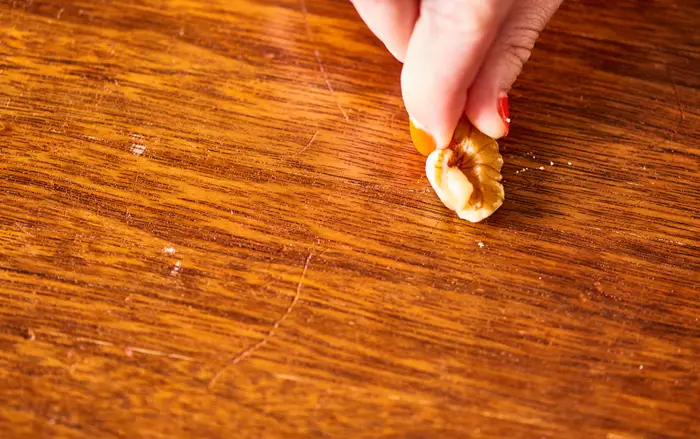
Step 1: Identify the Depth
Assess the scratch depth first.
- Shallow scratches don’t penetrate the polyurethane finish and can often be addressed by polishing.
- Deeper scratches penetrate the polyurethane finish and will require more advanced repair techniques.
2. Shallow Scratches
For shallow scratches:
- Use a fine, 4/0 steel wool or a high-grit (over 600) sandpaper to gently buff out the scratch. Try to buff in the direction of the grain.
- After this, apply a thin layer of polyurethane finish with a high-quality paintbrush or a foam brush to the scratched area.
- Allow it to dry
3. Deep Scratches
For deeper scratches:
- Use a clean cloth to apply a matching wood filler. Once the filler dries, sand it down to the level of the surrounding surface using high-grit sandpaper.
- Then, apply a thin layer of polyurethane finish with a paintbrush or a foam brush to the scratched area.
- Allow it to dry.
FAQs
Here are some common queries related to cleaning polyurethane surfaces that you might have in your mind.
Q1. What are the best products and tools to use for cleaning polyurethane?
For cleaning polyurethane, water, and mild soap are highly effective. Specific products like Minwax Hardwood Floor Cleaner can also be useful. Use soft, lint-free cloths to avoid scratching. For tools, microfiber cloths and sponges are optimal.
Q2. How often should I clean polyurethane surfaces?
Polyurethane surfaces should ideally be cleaned every 1-2 weeks, depending on use. Regular cleaning prevents the build-up of grime and maintains the finish.
3. How do I remove dried or hardened polyurethane from brushes or applicators?
To remove dried polyurethane from brushes, a brush cleaner or mineral spirits should be used. Soak the brushes and gently remove the hardened material.
4. How do I remove dust, dirt, or debris from polyurethane surfaces before applying a new coat?
A vacuum with a brush attachment is effective for removing dust and debris from polyurethane surfaces. In addition, you can also wipe the surface down with a damp, lint-free cloth.
5. What is the ideal humidity and temperature for cleaning polyurethane?
For humidity, temperature, and ventilation issues, ensure the room is well-ventilated but not drafty. Keep temperatures around 70°-75°F and humidity around 50%-70%.
Final Takeaways
As we come to the end of our polyurethane guide, here are the key takeaways to remember:
- Always use a non-abrasive, neutral pH cleaning agent to clean polyurethane finishes.
- Avoid products containing harsh chemicals such as ammonia or bleach.
- For scratches, identify the depth of the scratch. Shallow scratches can be buffed out with high-grit sandpaper or steel wool, while deeper scratches require a wood filler.
Remember, cleaning polyurethane doesn’t merely involve scrubbing the surface. It’s a process requiring an understanding of the material, careful selection of cleaning agents, and a gentle touch.




